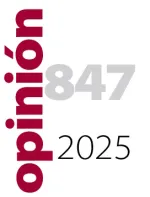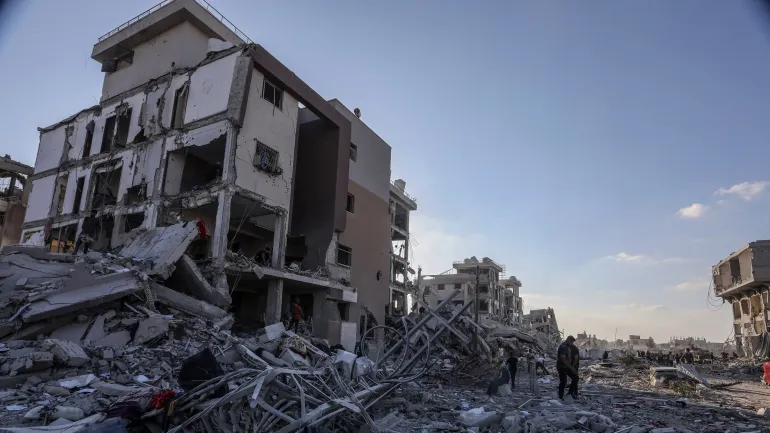Peace through strength? What Trump’s plan means for Palestine and global politics


Presented as a roadmap to peace, Trump’s plan for Gaza appears little more than power politics dressed up as diplomacy. While this might explain the rallying support from the international community, the risk is confusing short-term negotiations on a ceasefire with the broader need for sustainable post-war scenarios. Caught between the interests and the rhetoric of the parties involved, questions about Palestine's future remain open.
The so-called peace plan advanced by US President Donald Trump arrived last week with the promise of ending the war in Gaza. Its surface appeal is undeniable: who could oppose a proposal that aims to stop the slaughter and resolve the Israeli-Palestinian conflict? Not only European countries, but also Arab and Muslim nations seem to support it. Yet, Hamas seemed to be caught between two fires: accept the deal to halt the genocide or reject it in hopes for further compromises, but aware it could be seen as allowing Israel to “finish the job”.
With negotiations in Egypt ongoing, Hamas managed to strike a balance against the “take it or leave it” dilemma posed by Trump. On the one hand, the group showed its readiness for discussions about the points of a ceasefire, exchange of captives, resumption of humanitarian aid to Gaza, and the Hamas-free governance of post-war Gaza. On the other hand, it carefully postponed the wider discussion about the political future of the Strip and the Palestinian question. In other words, Trump’s plan has not worked as an ultimatum. Hamas neither accepted nor refused; it asked for a place at a negotiation table that had not included Palestinians.
Indeed, none of the minimum conditions for a genuine peace deal are met under Trump’s framework. Not only did Palestinians play no role in the design of this plan—unlike the Israelis and Arabs—, but the proposed “International Stabilisation Force” and technocratic governance for Gaza seem more like a remake of a British mandate led by Trump and Tony Blair than an inclusive proposal for all the parties involved. Second, there are no safeguards against Israeli military actions. Third, the plan mentions Palestinian statehood only in the penultimate clause, framed in vague references to a “credible path to self-determination.” Far from a concrete roadmap, this serves as a symbolic concession intended primarily to secure Arab acquiescence. The underlying message to Palestinians is clear: they are treated not as agents of their own future, but as objects to be managed by external powers.
Against this backdrop, Hamas and many other Palestinian factions consider that Trump’s so-called peace plan is, in fact, an attempt by Israel to impose through the US what it has failed to achieve through war. As a matter of fact, the plan is indeed aligned with Israel’s objectives: liberation of hostages, permanent military presence in the Strip, and the exclusion of Hamas and the Palestinian Authority from any future role. For Hamas, the dilemma is striking. Acceptance would mean unconditional surrender without any guarantees for its population, while rejection would risk reinforcing the narrative that Hamas alone is obstructing peace, effectively giving Israel carte blanche to pursue the destruction of Gaza. In this context, the group’s strategy is twofold: to craft a response that appears to accept Trump’s plan, while agreeing only to the terms the group had already pushed for in previous rounds of negotiations, namely, a ceasefire, humanitarian aid, and the exchange of captives.
These calculations highlight a fundamental divergence: while the U.S. and Israel frame the plan as both an immediate and ultimate solution, Palestinians see it as only one stratum of a two-layered process. The first deals with the most urgent discussion: a ceasefire to end the tragedy in Gaza, for which Hamas claims to be entitled as the main negotiator. The second, Palestinian sovereignty, is –according to Hamas– a matter to be discussed with all Palestinian factions. In other words, the group fears that tying these two distinct questions together would harm both its position and Palestinian interests, therefore it seeks to address them separately.
This divergence contrasts sharply with the international consensus forming around Trump’s proposal. While Hamas aims to separate the ceasefire from the question of sovereignty, many Arab and European states seem ready to endorse the package deal despite its flaws and contradictions. The fact that so many governments have rallied behind it suggests that the problem lies not only in the plan’s substance but in the broader international environment. What is at stake is less the technical detail of the proposal than the willingness of states to bear political costs at home and to reconcile proclaimed values with strategic interests. These reactions expose how we arrived here: a normalisation of Israeli impunity, sustained by US backing and tolerated by most of its allies.
Europe’s response is perhaps the least surprising. While public opinion and mass demonstrations have pushed governments toward more critical rhetoric, structural dependence on Washington and internal EU divisions remain decisive. Despite the many nuances in the stances of European countries, they are all now confronted with a common contradiction. Some of the same governments that formally recognised Palestine are now endorsing a plan that institutionalises the split between Gaza and the West Bank, and erases any credible horizon for Palestinian sovereignty in the Gaza Strip. This contradiction—if proof were ever needed—underscores how purely symbolic those recognitions have been.
If Europe’s position was relatively predictable, another question remains on the table: why, despite the plan’s flaws and risks, are Arab and Muslim states also supporting Trump’s proposal? Several factors explain this alignment. Structurally, the asymmetry of power with the United States is key. Washington knows that gaining the support of the Muslim world would enhance the plan’s legitimacy. At the same time, regional governments are aware that only Washington has the leverage to pressure Israel, as shown by Netanyahu’s recent visit to Washington.
However, doubts persist over whether the Israeli Prime Minister will abide by any commitments, constrained by his far-right coalition and domestic pressures. Leaked reports of pre-publication consultations described tense exchanges between the US and MENA countries, with the latter objecting to Israeli conditions that reshaped the plan. Disputes focused on two issues: leadership of the so-called stabilisation force—Israel rejects both UN and regional control—and credible guarantees that Tel Aviv will halt military operations in Gaza and abroad against states accused of hosting Hamas leaders, as recently seen in Qatar.
At the same time, a crucial mistake lies in the tendency to look at Arab and Muslim states as a unified bloc. In reality, their reactions to the plan reflect three elements: their varied ties to Hamas, the salience of the Palestinian cause in domestic politics, and broader strategic and economic interests that reach far beyond the conflict. For instance, Saudi Arabia leverages its “privileged relationship” with Washington to promote a regional order akin to “Abraham Accords 2.0”, where normalisation with Israel is exchanged for economic and security gains. The United Arab Emirates sees commercial opportunity in reconstruction, while Egypt views the weakening of Hamas as a blow against the Muslim Brotherhood “threat” and prioritises border control in Rafah to contain potential refugee flows.
Instead, more cautious and “wait-and-see” stances characterise the approaches of Turkey and Qatar. Ankara presents itself as the “protector” of Hamas and the Palestinian cause while simultaneously seeking to mediate with the West —a double-track strategy that bolsters Erdoğan’s domestic legitimacy and positions Ankara as a potential guarantor in post-war arrangements. As seen in other scenarios, such as Syria and Ukraine, Turkey might aim for a leading role in further negotiations and eventual peacekeeping missions. Doha, by contrast, finds its influence curtailed after Israeli strikes on its territory — tacitly tolerated by Washington — leaving its relations with the US strained and its leverage over Hamas diminished. However, such a stance should not obscure the fact that both Turkey and Qatar also pursue their own strategic interests. It is quite telling that the son of Trump’s Middle East Envoy Steve Witkoff reportedly sought money from Gulf states, including Qatar, while the elder Witkoff met with regional mediators on the Gaza ceasefire. Similarly, Turkey has never hidden its interests in reconstruction opportunities in regional post-conflict scenarios.
Viewed in this light, despite their differences, what unites Arab and Muslim states in their reactions is their need to strike a balance between national interests, domestic opinion on the Palestinian question, and adaptation to a shifting regional order. The risk, in this calculus, is that Palestine itself remains a secondary issue, and that the future of Gaza is contingent upon strategic agreements, reconstruction contracts, border security, and regional rivalries.
What emerges, therefore, is not a peace plan but a mechanism for managing the conflict while preserving Israel’s freedom of action. By endorsing Trump’s initiative, Europeans and Arabs alike reveal not confidence in its merits but a reluctance to confront the political costs of genuine compromise and accountability. The result is the consolidation of the very dynamics that produced the crisis in the first place: asymmetry, impunity, and the denial of Palestinian agency.
Keywords: israel, Hamas, Palestine, Gaza, peace plan, ceasefire, Trump, negociations, diplomacy, post-war, Middle East
All the publications express the opinions of their individual authors and do not necessarily reflect the views of CIDOB or its donors.
E-ISSN 2014-0843